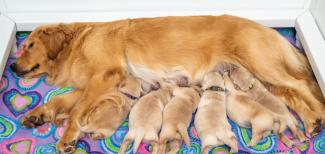Nesting is a primary maternal instinct of an expectant brood bitch. Pregnant dogs in the wild would select a secluded spot with adequate warmth and shelter and then camouflage the den with grass, sticks, branches, and brush. Although bitches producing purposefully bred litters today have whelping boxes provided for them, that nesting instinct remains intact.
Nurturing a pregnant dog’s nesting instinct entails introducing her to the whelping box at least five days before her delivery date. This allows time for her to become adjusted and comfortable before the puppies are born. Breeders often choose a small room in their home or kennel that is quiet and secluded to set up the whelping box.
Many considerations go into setting up the ideal whelping box for your breed of dog. Importantly, the size should be appropriate — large enough for a dam to stretch out with some room to spare — as a box that is too large can cause her great distress. It is easier for the dam to protect puppies that are close to her, and a box that is too large allows the puppies to move away from their mother and puts them at risk of malnutrition and becoming cold.
Especially during the first week when puppies are not able to regulate their own body temperature and thus rely on the dam’s body heat and the warmth of littermates to maintain a normal body temperature, a supplemental heat source is important. A heat source in the center of the whelping box encourages puppies to stay away from the edges where there is greater risk for the dam to lie on them. Modern heat sources include radiant floor heating that uses thermometer-controlled water to circulate in the center of the floor. There are many options available to choose from.
Whether a breeder selects a commercial style or a custom-made whelping box, the most important aspects are the comfort and safety of the brood bitch and her litter.
Ideal Whelping Box
- Warm and dry
- Easy to clean
- Waterproof
- One and a half to two times the length of the dam, so she can stretch out in full length with room to spare
- Allows dam to get away from her puppies yet prevents puppies from escaping
- Has a railing or ledge — sometimes called a pigrail, bumper or puppy rail — 3 to 4 inches from the floor around the periphery to prevent the dam from crushing or suffocating a puppy caught between her body and the sides of the box
Best Bedding Material
- Soft and warm
- Good traction
- Easily cleaned and disinfected
- Insect free
- Allows moisture to be wicked away
- Not easily ingested by puppies
- Avoid hay, straw, shavings, or stiff particles that can cause eye and skin irritation to newborn puppies
- Avoid rags, blankets or carpeting that allow puppies to crawl underneath and potentially be smothered by the dam
Supplemental Heat Considerations
- Should be placed so puppies can move away if they become too hot
- Should not interfere with the dam getting up and down
- Should not expose puppies to electrical cords or outlet boxes to chew on
- Heat in the center of the whelping box encourages puppies to stay in the center, away from the edges where there is greater risk of the dam lying on them
- Appropriate heat sources include heat lamps, electric or water-filled heating pads, and microwavable heating pads

